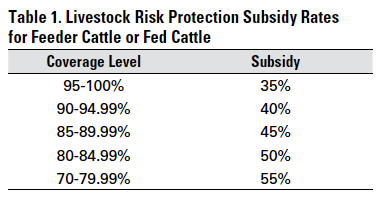Understanding Animals Threat Protection (LRP) Insurance Coverage: A Comprehensive Guide
Browsing the world of livestock danger security (LRP) insurance can be a complicated venture for numerous in the agricultural industry. This sort of insurance policy uses a safeguard versus market fluctuations and unexpected circumstances that could affect animals manufacturers. By recognizing the ins and outs of LRP insurance coverage, manufacturers can make informed decisions that might secure their operations from monetary risks. From exactly how LRP insurance functions to the numerous protection alternatives offered, there is much to reveal in this extensive guide that might potentially form the means animals manufacturers approach threat monitoring in their organizations.

How LRP Insurance Policy Functions
Occasionally, recognizing the auto mechanics of Animals Threat Protection (LRP) insurance policy can be intricate, yet breaking down just how it functions can supply quality for farmers and breeders. LRP insurance coverage is a danger administration tool made to secure livestock producers against unexpected price declines. It's crucial to keep in mind that LRP insurance policy is not a revenue warranty; rather, it concentrates entirely on price risk security.
Eligibility and Coverage Options

When it comes to coverage choices, LRP insurance coverage uses manufacturers the adaptability to select the coverage degree, insurance coverage period, and endorsements that best fit their danger monitoring requirements. Protection levels usually range from 70% to 100% of the anticipated finishing value of the insured livestock. Manufacturers can also select coverage periods that align with their manufacturing cycle, whether they are insuring feeder cattle, fed cattle, swine, or lamb. Recommendations such as rate danger protection can further customize coverage to protect against damaging market fluctuations. By recognizing the eligibility criteria and insurance coverage choices available, livestock manufacturers can make enlightened decisions to handle threat successfully.
Benefits And Drawbacks of LRP Insurance
When reviewing Animals Risk Protection (LRP) insurance policy, it is necessary for animals producers to weigh the drawbacks and benefits fundamental in this threat administration tool.

One of the key advantages of LRP insurance is its ability to offer security versus a decline in animals prices. In addition, LRP insurance policy supplies a level of flexibility, permitting producers to tailor insurance coverage degrees and policy durations to suit their specific requirements.
One constraint of LRP insurance is that it does not safeguard against all kinds of dangers, such as disease break outs or natural calamities. It is vital for manufacturers to carefully assess their private threat exposure and financial circumstance to figure out if LRP insurance is the ideal danger administration tool for their operation.
Recognizing LRP Insurance Premiums

Tips for Maximizing LRP Benefits
Taking full advantage of the benefits of Livestock Risk Defense (LRP) insurance needs critical planning and positive threat monitoring - Bagley Risk Management. To make the most of your LRP protection, consider the complying with ideas:
Consistently Evaluate Market Problems: Stay informed regarding market trends and cost changes in the livestock industry. By checking these aspects, you can make informed decisions about when to buy LRP coverage to secure against possible losses.
Set Realistic Protection Levels: When selecting insurance coverage levels, consider your manufacturing costs, market worth of animals, and prospective dangers - Bagley Risk Management. Establishing sensible coverage levels makes certain that you are appropriately protected without overpaying for unneeded insurance policy
Diversify Your Coverage: As opposed to relying solely on LRP insurance coverage, take into consideration expanding your danger management strategies. Incorporating LRP with various other threat monitoring devices such as futures contracts or options can provide thorough protection against market unpredictabilities.
Testimonial and Readjust Protection Frequently: As market conditions alter, occasionally assess your LRP coverage to ensure it aligns with your current danger exposure. Adjusting coverage levels and timing of purchases can aid enhance your threat defense strategy. By following these suggestions, you can make best use of the advantages of LRP insurance and guard your animals procedure versus unpredicted dangers.
Verdict
To conclude, animals threat protection (LRP) insurance her comment is here coverage is a valuable tool for farmers to take care of the economic risks connected with their animals operations. By comprehending exactly how LRP works, qualification and coverage options, in addition to the pros and disadvantages of this insurance policy, farmers can make enlightened choices to shield their incomes. By carefully taking into consideration LRP premiums and applying techniques to make best use of benefits, farmers can reduce possible losses and guarantee the sustainability of their procedures.
Animals manufacturers interested in acquiring Livestock Danger Protection (LRP) insurance coverage can check out an array of eligibility standards and insurance coverage options tailored to their specific animals procedures.When it comes to insurance coverage alternatives, LRP insurance coverage uses manufacturers the adaptability to choose the insurance coverage level, protection period, and recommendations that best fit their threat management requirements.To grasp the details of Livestock Threat Defense (LRP) insurance policy fully, comprehending the elements influencing LRP insurance coverage costs is important. LRP insurance premiums are identified by different aspects, including the coverage degree selected, the expected cost of animals at the end of the coverage duration, the type of livestock see here being insured, and the size of the protection period.Testimonial and Adjust Protection Consistently: As market problems alter, occasionally evaluate your LRP insurance coverage to guarantee it straightens with your current risk exposure.